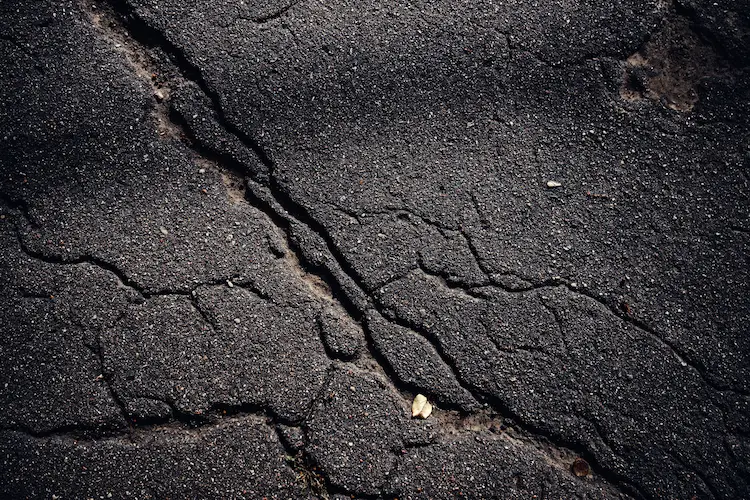Imagine your driveway as a puzzle, with cracks acting as missing pieces that disrupt the overall picture. Just like a puzzle, your pavement needs to be repaired before it can be properly sealed.
But why is crack repair before sealcoating so crucial? Well, my friend, the answer lies in the ability of sealcoating to effectively fix cracks of all sizes.
By diving into the world of crack repair, you’ll discover the hidden benefits that come with this essential step.
So, buckle up and get ready to explore the reasons why crack repair should be a priority before sealcoating your pavement.
Key Takeaways
- Crack repair before sealcoating is crucial for maintaining the overall condition and extending the lifespan of pavement.
- It prevents further expansion, deterioration, and the formation of potholes.
- Crack repair ensures optimal adhesion and flexibility of sealcoating, enhancing durability and surface quality.
- Proper crack repair and sealcoating application can prevent water infiltration, reduce the risk of damage, and provide long-term cost savings.
Importance of Crack Repair

To ensure the long-term durability and functionality of your asphalt pavement, it’s crucial to prioritize the crack repair process before moving forward with sealcoating. Proper crack repair plays a vital role in maintaining the overall condition of the pavement and extending its lifespan. By filling asphalt cracks with a suitable crack filling material, you can prevent further expansion and deterioration. This not only saves you money on costly repairs and replacements in the future but also reduces the risk of pothole formation.
When cracks are left untreated, they allow water infiltration and moisture damage, leading to structural issues. Filling asphalt cracks with an effective asphalt crack filler or crack sealing material prevents water from seeping underneath the surface, thus protecting the underlying layers. This helps maintain the integrity of the pavement and minimizes the chances of extensive damage.
Additionally, filling cracks before sealcoating improves the appearance of the asphalt parking lot or pavement. By addressing these minor imperfections, property owners can enhance the overall aesthetic appeal of their property, creating a positive impression on visitors and customers.
Benefits of Repairing Cracks First
Repairing cracks before sealcoating is essential for maintaining the structural integrity and longevity of your asphalt pavement. By addressing pavement cracks before applying sealcoating, you can enjoy several benefits:
- Prevents water infiltration and damage: Cracks in the asphalt surface allow water to penetrate, leading to further deterioration of the pavement. Repairing these cracks with a high-quality crack sealant helps prevent water infiltration, protecting the underlying layers and minimizing the risk of costly repairs.
- Extends the lifespan of the pavement: By filling the cracks, you can prevent them from expanding and developing into potholes. This proactive approach reduces the overall deterioration of the pavement, extending its lifespan and saving you money in the long run.
- Enhances pavement appearance: Unsightly cracks can make your asphalt surface look worn and neglected. Repairing these cracks before sealcoating improves the overall appearance of your pavement, providing a clean and well-maintained look.
- Improves durability and surface quality: Filling the cracks ensures a smoother surface for vehicles, reducing the risk of tire damage and enhancing the overall durability of the pavement. This creates a safer and more enjoyable driving experience.
- Optimal adhesion and flexibility of sealcoating: Repairing cracks before sealcoating allows for better adhesion and flexibility of the sealcoat. This ensures that the sealcoating material can effectively protect the asphalt surface, minimizing the chances of re-cracking and maximizing its protective properties.
To maintain the integrity of your asphalt pavement and ensure its long-term durability, it’s crucial to prioritize routine maintenance and fill the cracks before applying sealcoating. This proactive approach won’t only save you money on repairs but also provide a safer and more visually appealing asphalt surface.
Maximizing the Effectiveness of Sealcoating

In order to maximize the effectiveness of sealcoating, it is important to employ proper application techniques and ensure thorough coverage of the asphalt surface. Sealcoating is a crucial step in maintaining the longevity and durability of parking lots and other asphalt surfaces. By applying a protective layer to the surface, sealcoating helps to prevent damage from UV rays, water, and other elements. To ensure the best results, it is essential to follow the proper procedures and techniques.
One important aspect of sealcoating is crack repair. Before applying the sealcoat, all cracks should be filled and repaired. This not only improves the appearance of the surface, but also prevents water infiltration, which can lead to further damage. By addressing cracks before sealcoating, you are ensuring a more durable and long-lasting job.
To further maximize the effectiveness of sealcoating, proper surface preparation is crucial. This includes cleaning the surface thoroughly, removing any debris, and ensuring a smooth and even surface. A well-prepared surface allows for better adhesion of the sealcoat, resulting in a more effective seal.
In addition, using high-quality sealcoating products and equipment is essential. Investing in professional maintenance services that utilize top-notch materials and techniques can greatly enhance the effectiveness of the sealcoating job.
To summarize, maximizing the effectiveness of sealcoating involves employing proper application techniques, addressing cracks before sealcoating, thorough surface preparation, and using high-quality products. By following these guidelines, you can ensure a long-lasting and durable seal that protects your asphalt surface for years to come.
| Key Steps for Maximizing Sealcoating Effectiveness | |
|---|---|
| Employ proper application techniques | Ensure thorough coverage of the asphalt surface |
| Address cracks before sealcoating | Proper surface preparation |
| Use high-quality sealcoating products and equipment | Invest in professional maintenance services |
Preventing Further Damage With Crack Repair
Maximizing the effectiveness of sealcoating begins with addressing cracks before sealcoating, as this prevents further damage and ensures the longevity and durability of the pavement. Proper crack repair is crucial in maintaining the integrity of the asphalt surface. Here are a few reasons why crack repair is essential in preventing further damage:
- Preventing water infiltration: Cracks in the pavement allow water to seep through, which can lead to serious issues. Water can weaken the base layer of the pavement and cause it to deteriorate over time. By filling the cracks before sealcoating, you create a barrier that prevents water from penetrating the surface.
- Reducing the risk of potholes: Unrepaired cracks can expand and deepen, eventually forming potholes. These potholes not only damage vehicles but also pose a safety hazard to pedestrians. By addressing cracks early on, you can prevent them from growing in size and minimize the risk of pothole formation.
Enhancing the Longevity of Sealcoating

To ensure the maximum lifespan of sealcoating, it’s important to implement strategies that enhance its longevity. While crack repair is crucial to prevent further damage before sealcoating, there are additional steps you can take to optimize the effectiveness and durability of the sealcoating process.
One way to enhance the longevity of sealcoating is to prioritize regular maintenance and inspection. By regularly inspecting your asphalt surface for any signs of cracks or deterioration, you can address them promptly and prevent them from spreading. Additionally, scheduling routine sealcoating can help protect your pavement from the damaging effects of water, UV rays, and heavy traffic.
Another strategy to enhance the longevity of sealcoating is to use high-quality materials. Opt for a rubberized asphalt sealcoat, as it offers superior flexibility and durability. Rubberized asphalt is designed to withstand the stresses and movements of the underlying pavement, minimizing the risk of cracks and premature deterioration.
Furthermore, it’s crucial to apply the sealcoat correctly and in the appropriate conditions. Ensure that the surface is clean and free of debris before applying the sealcoat, as this will promote better adhesion. Additionally, sealcoating should be done when the temperature and humidity levels are within the recommended range, as this will optimize the curing process and enhance the longevity of the sealcoat.
Conclusion
To ensure the effectiveness and longevity of sealcoating, it’s crucial to repair cracks before applying the sealant. By addressing cracks of all sizes, we can prevent further damage, extend the pavement’s lifespan, and protect against water infiltration.
Remember, ‘An ounce of prevention is worth a pound of cure.’ So, take the necessary steps to repair cracks first and maximize the benefits of sealcoating.



